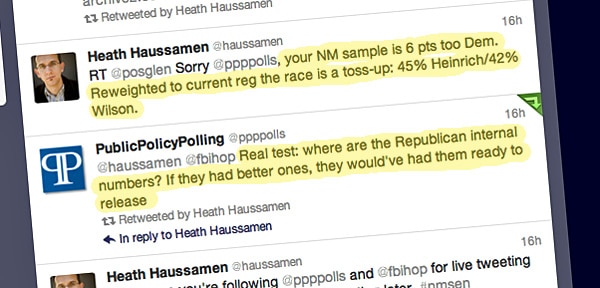
The U.S. Capitol building (Photo by Heath Haussamen)
A poll released Thursday has Democrat Martin Heinrich leading Republican Heather Wilson in a potential U.S. Senate match-up and Democrat Hector Balderas tied with Wilson, but there’s a debate about the survey’s integrity
A new poll released Thursday has Democrat Martin Heinrich leading Republican Heather Wilson by 7 percentage points in a potential U.S. Senate match-up and Democrat Hector Balderas tied with Wilson.
But Republicans immediately attacked the survey, which came from the left-leaning group Public Policy Polling (PPP), and started a public debate on Twitter and elsewhere.
The poll found Heinrich leading Wilson 47 percent to 40 percent, down two points from when she trailed Heinrich by 5 points in June. Wilson and Balderas were tied at 43 percent, which is a six-point gain for Wilson from June.
Other Republicans in the race trailed both Heinrich and Balderas by more than 10 points.
The survey of 500 New Mexico voters, “including 309 usual Democratic primary voters,” was conducted between Saturday and Monday and has a margin of error of plus or minus 4.4 percentage points.
“Democrats continue to have a modest advantage in the New Mexico Senate contest,” Dean Debnam, PPP president, said in the poll memo. “But it looks unlikely they’ll have the kind of cakewalk race they did in 2008 when Tom Udall was overwhelmingly elected to replace Pete Domenici.”
You can read about the poll here and find the polling memo here.
GOP attacks
The Republican Party of New Mexico quickly issued a news release with this headline: “Caution: Liberal Group Releasing Juiced Poll Numbers In State.” Republicans pointed out that the survey included more Democrats (52 percent) and fewer Republicans (29 percent) than are registered to vote in New Mexico (49 and 32 percent, respectively). And Republicans usually make up an even greater percentage of voters on Election Day (37 percent in 2010 and 34 percent in 2008).
“There is no explanation for reducing the GOP in the survey, except that this is a shameless attempt to cook the books for the Democrats,” Republican Party of New Mexico Executive Director Bryan Watkins said in the release.
The 2008 and 2010 turnout numbers were tweeted by Brian Walsh, head of the Republican National Senatorial Committee. Glen Bolger of the right-leaning Public Opinion Strategies, which is Wilson’s polling firm, tweeted this:
“Sorry #Public Policy Polling, your NM sample is 6 pts too Dem. Reweighted to current reg the race is a toss-up: 45% Heinrich/42% Wilson.”
And Wilson made this assertion on Facebook:
“PPP Poll out today assumes only 29% of the people who will vote will be Republicans and 52% Democrat – a 23% Dem advantage. That’s off by 6-10% from historical reality. They should just own up to it and fix their math. Split the difference between 2010 and 2008 turnout? Yhis (sic) is a 44-44 race.”
PPP defends its polling
My former New Mexico Independent colleague Matt Reichbach and I got into a discussion on Twitter with PPP about the survey. And I questioned PPP’s Tom Jensen by e-mail bout the GOP claims.
Jensen pointed out that PPP’s last 2010 poll “came without on point” of Gov. Susana Martinez’s margin of victory, and that its final poll on the 2008 election in New Mexico “was the most accurate in the state that year.”
“There’s a reason the Republican release doesn’t make any reference to our past polling in New Mexico: because it’s been right on the mark and unbiased,” Jensen told me.
As for the weighting (35 percent of those surveyed in that “most accurate” 2008 poll were Republicans, which was close to actual turnout), Jensen said this:
“…we had fewer Republicans on today’s poll than the 2008 poll, but we also had a sample of independents that was much more Republican leaning than 2008, as shown by Wilson winning those voters. Party ID shifts over time and people who may have identified as Republican in 2008 are now identifying as independent, but still voting Republican. That’s a product of the Tea Party movement – folks might not want to call themselves Republicans anymore but they’re still supporting GOP candidates under a different label.”
He also took this parting shot:
“One other thing: Wilson’s polling company, Public Opinion Strategies, released a memo in early October blasting our polling on Ohio Issue 2, the collective bargaining amendment the state voted on last month. Our polling showed it failing by more than 20 points and it ended up failing by more than 20 points just like we said. The link to the statement is here but as you can see it’s been conveniently scrubbed from the internet:
“http://www.betterohio.org/news/2011/10/statement-regarding-public-policy-polling-survey”
‘Dem cheerleaders’ or ‘pretty darn accurate?’
PPP tweeted that it was “honored that the good folks at the New Mexico Republican Party spent so much time googling PPP this week” and that, if the GOP had more favorable internal polling numbers, “they would’ve had them ready to release.”
Walsh’s response: “Honored? Some might think you’d be embarrased (sic) to have your misleading poll sample exposed like that. It’s off and you know it too.”
And Walsh suggested that, while PPP releases accurate polls right before elections, as it did in 2008 and 2010, at this stage in the game it’s doing something different.
“oh you guys may try to get it right just before the election but a year out you’re Dem cheerleaders. NM sample says it all,” Walsh tweeted.
“Not a secret to anyone that we’re Democrats, not a secret to anyone (even you) that we’re pretty darn accurate. God Bless,” was PPP’s response.
About the new poll
On to the poll. First off, in a survey of the 309 Democratic primary voters, Heinrich led Balderas 47 percent to 30 percent. That’s an improvement for Balderas from the last time PPP polled and Heinrich led 47-24. It’s noteworthy that Heinrich didn’t move any closer to 50 percent while Balderas gained.
I wrote about the PPP GOP primary survey on Thursday. It essentially showed Wilson dominating and no other candidate gaining ground.
As for the general election poll released Thursday (Heinrich leading Wilson 47-40 and Wilson and Balderas tied at 43), it’s noteworthy that while Wilson slipped two points against Heinrich from the last PPP poll in June, she gained against Balderas. He led her by six points in June.
Here’s more on the poll from PPP’s memo:
“Wilson does as well as she does because she earns 17% of the Democratic vote versus Heinrich and 20% versus Balderas. She has also turned a nine-point deficit versus Balderas and twelve points against Heinrich with independents into leads of 20 and six, and she has locked up more of the Republican vote. But independents are only 19% of voters, and Republicans 29%, versus Democrats’ 52%. Heinrich’s own improvement with Democrats more than makes up for his decline with Republicans and independents. The only area where Balderas outdoes Heinrich is with Republicans (10% versus 6%).”
“Balderas has moved from 24% to 30% in the primary since June, but Heinrich is holding steady at 47%.”
The bottom line
Eleven months before the general election, the bottom line is the same regardless of whether the PPP poll is accurate or the Republicans’ criticism is correct: Wilson is dominating her primary race. At this point, no other Republican candidate has shown positive movement. Heinrich has a strong lead in his race, but Balderas has gained some ground and can’t be ignored.
Wilson, Heinrich and Balderas are all solid candidates. In New Mexico, general election races between solid candidates are usually close. There’s reason to believe any of the three has a shot at winning the race, though Wilson and Heinrich have better shots than Balderas. It’s no surprise to see polls showing tight contests between Wilson and the two Democrats.
Whether Wilson and Heinrich are currently separated by seven points or none, the reality is that it’s close. Eleven months out, anything can happen.
This is probably going to be quite a race.

A scene from Thursday’s Twitter debate about the integrity of the Public Policy Polling survey. The highlights are mine.